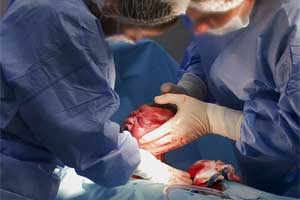- Home
- Editorial
- News
- Practice Guidelines
- Anesthesiology Guidelines
- Cancer Guidelines
- Cardiac Sciences Guidelines
- Critical Care Guidelines
- Dentistry Guidelines
- Dermatology Guidelines
- Diabetes and Endo Guidelines
- Diagnostics Guidelines
- ENT Guidelines
- Featured Practice Guidelines
- Gastroenterology Guidelines
- Geriatrics Guidelines
- Medicine Guidelines
- Nephrology Guidelines
- Neurosciences Guidelines
- Obs and Gynae Guidelines
- Ophthalmology Guidelines
- Orthopaedics Guidelines
- Paediatrics Guidelines
- Psychiatry Guidelines
- Pulmonology Guidelines
- Radiology Guidelines
- Surgery Guidelines
- Urology Guidelines
Norepinephrine safely treats Spinal-induced hypotension during Cesarean

Hemodynamic profile offered by Norepinephrine (NE) during Cesarean delivery (CD) is superior to that of Phenylephrine (PE) due to less fluctuations in heart rate (HR) and possibly cardiac output, reports a study published in the journal Anesthesia & Analgesia.
Phenylephrine is currently the vasopressor of choice to prevent and treat spinal-induced hypotension at cesarean delivery. However, its use is often associated with reflex bradycardia. Norepinephrine has been put forward as an alternative vasopressor during CD due to its ability to treat hypotension while maintaining heart rate (HR).
Aidan M. Sharkey and his associates hypothesized that when used in equipotent doses as an intermittent bolus regimen to prevent and treat spinal-induced hypotension, NE would result in a reduction in the incidence of bradycardia compared to PE.
The researchers conducted a double-blind, randomized clinical trial of women undergoing elective CD under spinal anesthesia. 112 women were randomized to receive either PE 100 µg or NE 6 µg when the systolic blood pressure (SBP) was below baseline. Besides randomized treatment, ephedrine was given intravenously to both groups if the SBP was below baseline and the HR <60 bpm or if the SBP was <80% of baseline for 2 consecutive readings.
Read Also:Labor induction at 39 weeks reduces need for cesarean section: NEJM
The primary outcome was bradycardia (HR <50 bpm) in the pre-delivery period. Secondary outcomes included hypotension (SBP <80% of baseline), hypertension (SBP >120% of baseline), tachycardia (HR >120% of baseline), ≥2 episodes of bradycardia, nausea, vomiting, umbilical artery and vein blood gases, and Apgar scores.
Key study findings:
- The incidence of bradycardia was lower in the NE group compared to the PE group (10.9% vs 37.5%), implying an estimated 71% relative reduction.
- The distribution of the number of bradycardia episodes was also different between the 2 groups.
- Further testing showed that the patients in the PE group had a higher risk of multiple bradycardia episodes (≥2 episodes) compared to the NE group (19.6% for PE versus 3.6% for NE).
- The proportion of patients requiring rescue boluses of ephedrine was lower in the NE group compared to the PE group (7.2% for NE versus 21.4% for PE).
- No differences were observed between the 2 groups in the incidence of other secondary outcomes.
“When used as an intermittent bolus regimen to prevent and treat spinal-induced hypotension during CD, NE resulted in a significant reduction in the incidence of bradycardia as compared to an equipotent bolus regimen of PE, write the authors.
For reference log on to 10.1213/ANE.0000000000003704

Disclaimer: This site is primarily intended for healthcare professionals. Any content/information on this website does not replace the advice of medical and/or health professionals and should not be construed as medical/diagnostic advice/endorsement or prescription. Use of this site is subject to our terms of use, privacy policy, advertisement policy. © 2020 Minerva Medical Treatment Pvt Ltd